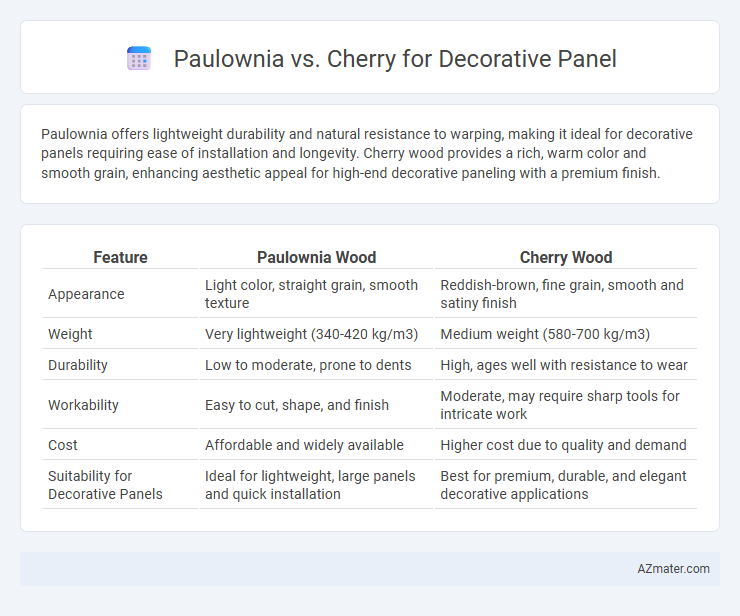Paulownia offers lightweight durability and natural resistance to warping, making it ideal for decorative panels requiring ease of installation and longevity. Cherry wood provides a rich, warm color and smooth grain, enhancing aesthetic appeal for high-end decorative paneling with a premium finish.
Table of Comparison
| Feature | Paulownia Wood | Cherry Wood |
|---|---|---|
| Appearance | Light color, straight grain, smooth texture | Reddish-brown, fine grain, smooth and satiny finish |
| Weight | Very lightweight (340-420 kg/m3) | Medium weight (580-700 kg/m3) |
| Durability | Low to moderate, prone to dents | High, ages well with resistance to wear |
| Workability | Easy to cut, shape, and finish | Moderate, may require sharp tools for intricate work |
| Cost | Affordable and widely available | Higher cost due to quality and demand |
| Suitability for Decorative Panels | Ideal for lightweight, large panels and quick installation | Best for premium, durable, and elegant decorative applications |
Introduction to Paulownia and Cherry Woods
Paulownia wood is lightweight, fast-growing, and known for its fine grain and natural resistance to warping, making it ideal for decorative panels requiring stability and ease of handling. Cherry wood exhibits a rich, warm reddish-brown hue with a smooth texture that deepens over time, prized for its durability and elegant appearance in high-end paneling. Both woods offer unique aesthetic and structural qualities, with Paulownia favored for lightness and sustainability, while Cherry provides classic beauty and long-lasting strength.
Wood Grain and Aesthetic Appeal
Paulownia wood features a light, uniform grain with subtle patterns, offering a modern and clean aesthetic ideal for decorative panels in minimalist or contemporary interiors. Cherry wood exhibits rich, warm tones with a pronounced, flowing grain that deepens over time, adding classic elegance and visual depth to decorative applications. The choice between the two hinges on desired ambiance: Paulownia delivers a sleek, airy feel, while Cherry provides warmth and traditional charm.
Color and Visual Characteristics
Paulownia wood features a light, creamy color with subtle grain patterns, providing a smooth and modern aesthetic ideal for decorative panels. Cherry wood is known for its rich, warm reddish-brown tones that deepen with age, offering a classic and elegant look. The visual contrast between Paulownia's pale, uniform appearance and Cherry's vibrant, complex grain makes each suited for distinct interior design styles.
Durability and Longevity
Paulownia wood offers superior durability for decorative panels due to its natural resistance to moisture and decay, making it ideal for long-lasting indoor and outdoor applications. Cherry wood, while prized for its rich color and smooth grain, tends to be less resistant to environmental wear and requires more maintenance to maintain longevity. Choosing Paulownia ensures enhanced panel durability and extended lifespan with minimal upkeep compared to Cherry.
Workability and Machinability
Paulownia wood offers exceptional workability due to its light weight and soft texture, allowing for easy cutting, shaping, and sanding in decorative panel applications. Cherry wood, while denser and harder, provides a smoother finish and excellent machinability, making it ideal for detailed carvings and high-quality paneling. Both species respond well to staining and finishing, but Paulownia excels in rapid machining processes, whereas Cherry delivers superior durability and refined aesthetics.
Environmental Impact and Sustainability
Paulownia offers superior environmental benefits for decorative panels due to its rapid growth rate and ability to sequester carbon efficiently, making it a sustainable wood choice. Cherry, while valued for its rich aesthetics and durability, grows significantly slower and has a higher environmental footprint from longer cultivation periods and more intensive resource use. Choosing Paulownia over Cherry enhances sustainability efforts by reducing deforestation pressure and promoting responsible forestry management.
Cost Comparison
Paulownia offers a cost-effective option for decorative panels due to its fast growth rate and lower harvesting expenses, resulting in lower market prices compared to cherry wood. Cherry panels typically demand higher investment because of the wood's fine grain, durability, and slower growth cycle, which increases production costs. For budget-conscious projects, paulownia provides a more affordable alternative without sacrificing aesthetic appeal, whereas cherry incurs premium pricing reflecting its premium quality and long-term value.
Finishing and Maintenance Requirements
Paulownia wood offers a smooth surface that readily absorbs finishes, allowing for vibrant stains and sealants ideal for decorative panels, while its lightweight nature reduces cracking risks during drying. Cherry wood has a naturally fine and uniform grain that enhances the richness of stains and oils, though it requires more frequent maintenance to preserve its deep reddish hue and prevent surface wear. Both woods benefit from regular dusting and occasional reapplication of protective finishes, but cherry panels typically demand more attentive care to maintain their aesthetic appeal over time.
Applications in Decorative Panels
Paulownia wood offers lightweight durability and a fine, even grain ideal for decorative panels in interior design, enhancing wall cladding and furniture surfaces with a natural, smooth finish. Cherry wood provides a rich, warm color and tight grain structure, making it a premium choice for high-end decorative panels that require elegance and long-lasting beauty. Both woods are favored in decorative applications, with Paulownia excelling in moisture resistance and Cherry valued for its pronounced aging characteristics and color depth.
Choosing the Right Wood for Your Project
Paulownia wood offers a lightweight, soft texture with excellent workability and natural resistance to decay, making it ideal for decorative panels requiring ease of installation and longevity. Cherry wood provides a rich, warm hue with fine grain and superior durability, enhancing the aesthetic appeal and strength of high-end decorative projects. Selecting between Paulownia and Cherry depends on your priorities for weight, appearance, and durability in the decorative panel application.

Infographic: Paulownia vs Cherry for Decorative Panel
 azmater.com
azmater.com